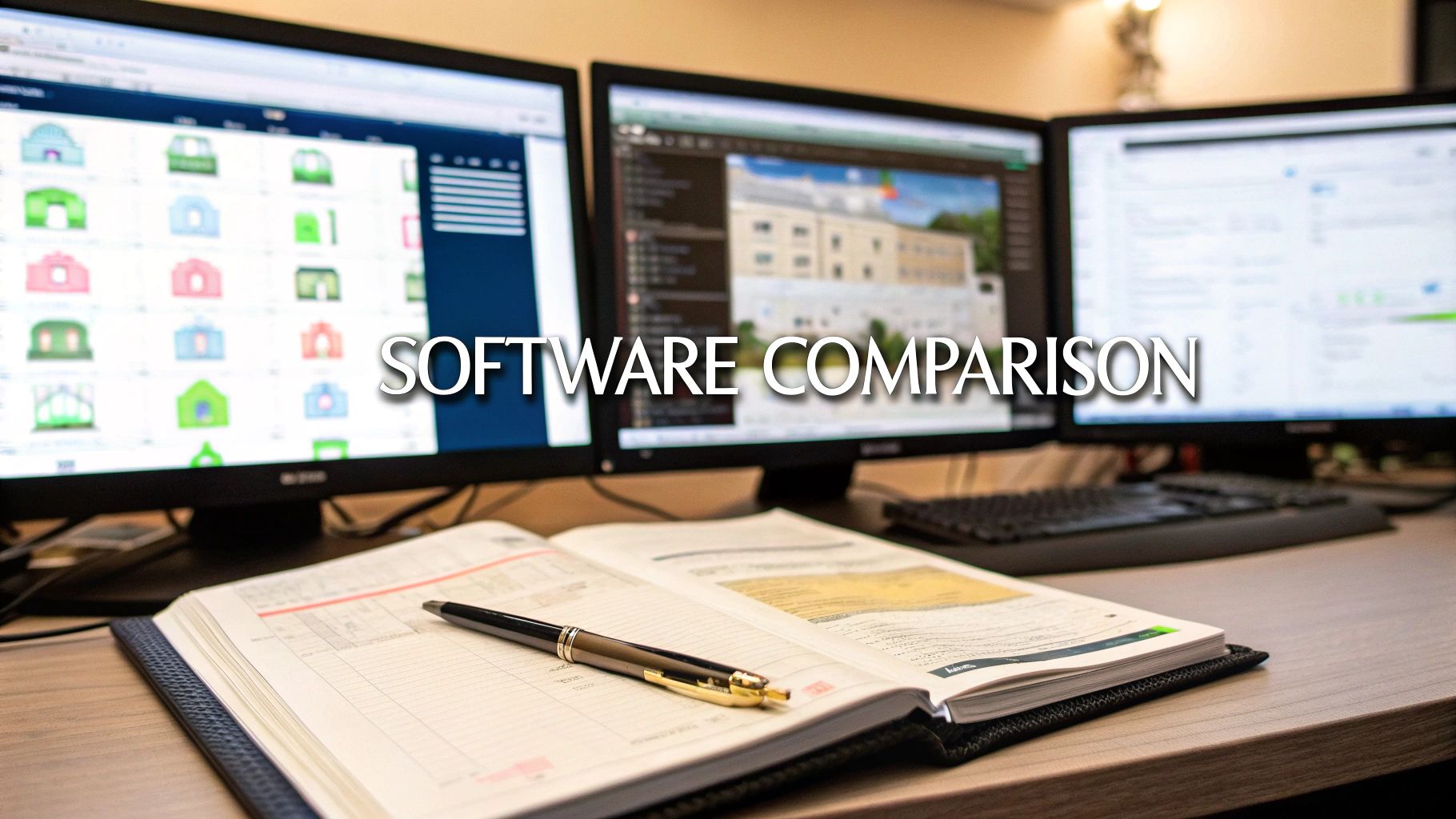Picking the right property management software is a make-or-break technology decision for your portfolio. This guide cuts through the noise with a detailed property management software comparison, helping you make a confident choice. We're going beyond basic feature checklists to see how the top platforms actually stack up in the real world for multifamily, commercial, and hospitality operators.
Choosing Your Property Management Software
We'll dig into the essentials—from accounting and tenant communication to security and integrations—so you can find a system that truly simplifies your operations, strengthens tenant relationships, and ultimately, boosts your bottom line. The market itself shows how crucial this is. Its value is expected to jump from USD 27.95 billion in 2025 to a massive USD 54.16 billion by 2032, all thanks to the push for digitalization in real estate.
This decision is less about ticking off features and more about finding a genuine technology partner that gets your business goals. When you start looking, it helps to borrow strategies from other big software decisions. For instance, learning how to choose the right CRM software can give you a solid framework for mapping out your needs. The key is to match your biggest operational headaches with specific software solutions.
Key Evaluation Pillars
Before we jump into a head-to-head comparison, let's establish the core pillars that should frame your decision. These are the fundamentals that ensure whatever platform you choose will deliver real value for years to come.
- Operational Fit: Does the software actually solve your day-to-day problems? Think automated rent collection, streamlined maintenance requests, or handling tricky commercial leases.
- Scalability: Will this platform grow with you? A system that’s perfect for 50 units might buckle under the pressure of 500.
- Tenant Experience: How does the software make life better for your residents or guests? A smooth, user-friendly tenant portal can do wonders for satisfaction and retention.
- Integration Capability: Can it play nice with the tools you already use? Seamless connections to your accounting software, smart home tech, or marketing platforms are non-negotiable. For a closer look at this, our guide on essential technology for property management is a great resource.
Establishing Your Software Evaluation Framework
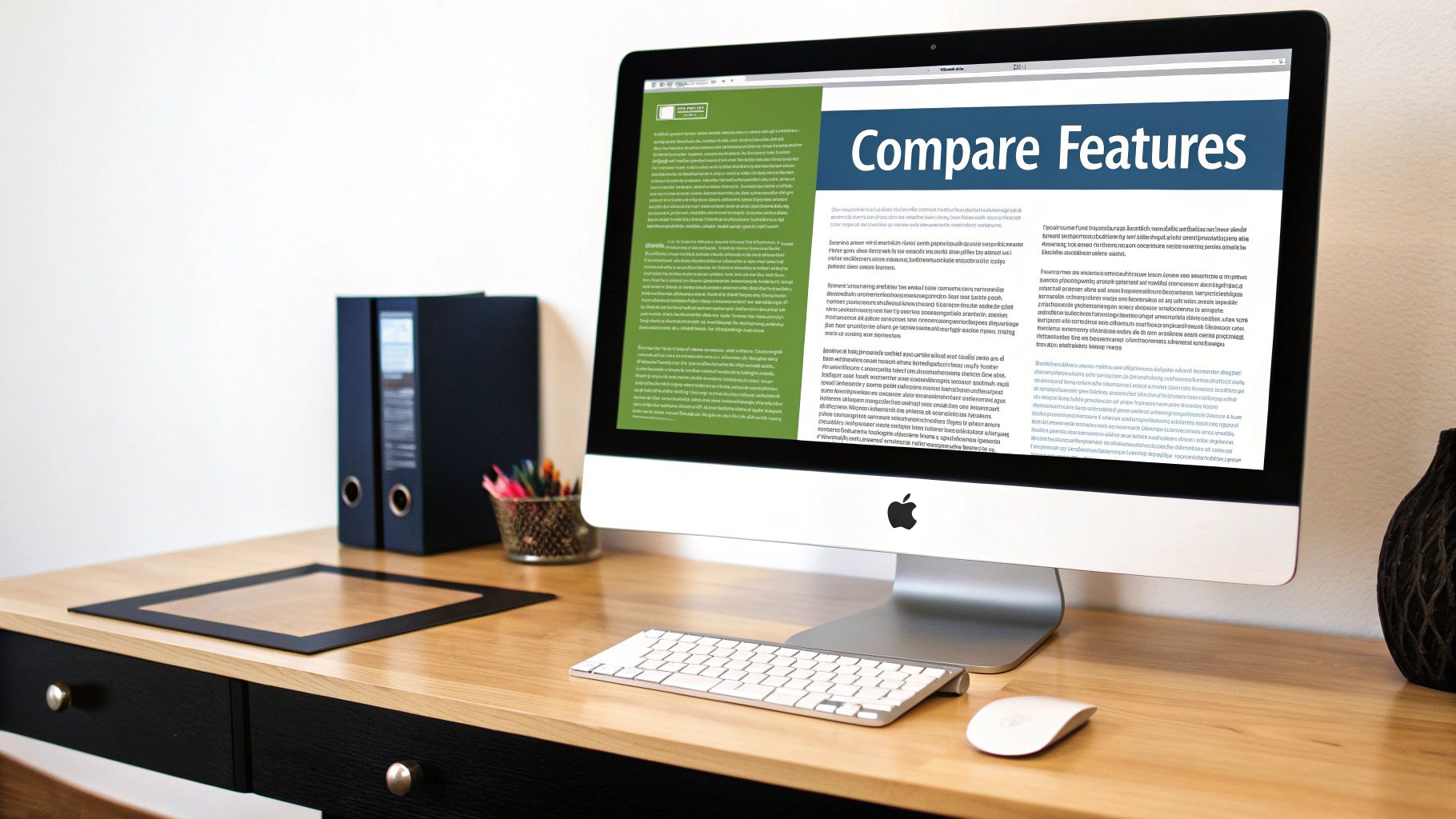
Jumping into software demos without a plan is a classic mistake. It's a bit like going grocery shopping when you're starving—everything looks amazing, and you leave with a cart full of things you don’t actually need. A solid evaluation framework is your shopping list; it keeps your property management software comparison focused and grounded in reality.
The first step is a frank look at how you operate right now. Get specific about the daily headaches that are bogging down your team. Are you spending hours manually reconciling rent payments? Is your maintenance coordination a messy mix of emails, texts, and sticky notes? Nailing down these pain points is how you start to find a solution that really moves the needle.
Once you know the problems, you can start mapping them to specific software features. This is where you need to be honest about what's a non-negotiable versus what's just a "nice-to-have." This simple exercise will keep you from getting distracted by a slick-looking feature that doesn't solve any of your core operational bottlenecks.
Defining Your Core Requirements
With your pain points clearly listed, it's time to build a scorecard. This isn't just busy work; it's a tool to keep your team objective and consistent as you look at different platforms. Make sure it’s tailored to your world, whether that's multifamily, commercial, or hospitality.
Start with the absolute deal-breakers—your must-have functions.
- Accounting Automation: Does the software truly handle accounts payable and receivable? Can it perform bank reconciliations and generate owner statements without needing a bunch of manual exports and workarounds?
- Maintenance Workflow Management: Can you see the entire lifecycle of a work order—from creation to vendor assignment and final invoice—in one place? A central dashboard with communication logs is key.
- Tenant Screening and Leasing: How smooth is the process for prospects? Look for integrated background checks, online applications, and a digital lease-signing flow that doesn't feel clunky.
- Mobile Accessibility: Is there a true mobile app for your team in the field, or is it just a shrunken-down version of the website? The difference in usability is massive for on-the-go tasks.
People often make the mistake of undervaluing a clean user interface (UI) and a smooth user experience (UX). If the software isn't intuitive for your team to use every day, they simply won't use it. Adoption will fail, and you'll never get the promised value, no matter how powerful the features are.
Assessing Support and Scalability
Looking past the feature list, your framework needs to weigh the potential for a long-term partnership. The way a software company supports its customers says a lot about the product and the team behind it. Dig into reviews that talk specifically about customer service response times and the quality of their training resources, like video tutorials or live onboarding sessions.
Finally, think about where you'll be in five years. The right software solves today's problems without boxing you in tomorrow. Ask vendors directly how their pricing and feature sets scale as you add more properties. A platform that's perfect for 50 units needs to work just as efficiently when you hit 500—without forcing you to completely change how you operate or swallow a massive price hike. This kind of forward-thinking is what turns a software purchase into a long-term investment.
Comparing Top Property Management Platforms
Alright, let's move past the theory and get down to the brass tacks. This is where the real work of your property management software comparison starts. We're going to put major players like AppFolio, Yardi, Buildium, and Entrata under the microscope to see how they actually handle the high-stakes, day-to-day grind of property management.
The goal here isn't to crown one "best" platform. Instead, it’s about figuring out which one slots perfectly into your specific workflow and portfolio. It’s easy to get mesmerized by a long list of features, but the real story is in how each system handles core tasks like complex lease management, rent collection, and tenant communication. Those nuances are what really separate the contenders.
Lease Management and Automation
How a platform handles a lease from start to finish is a massive differentiator. We're talking about more than just a digital filing cabinet for PDFs. True lease management is about automating renewals, flagging critical dates, and wrestling with complex commercial lease clauses like variable charges.
- AppFolio shines with its incredibly intuitive interface, especially for residential leasing. The whole digital process is seamless for both tenants and managers, which is a huge win for multifamily operators who deal with a high volume of standardized leases.
- Yardi Voyager, on the other hand, brings unmatched depth for commercial and mixed-use portfolios. It can chew through complex CAM reconciliations and percentage rent calculations—the kind of stuff that’s an absolute deal-breaker for most retail or office managers.
- Buildium finds a nice middle ground. It offers solid lease-tracking tools that are easy to pick up, making it ideal for small to mid-sized residential portfolios. It might not have Yardi’s commercial horsepower, but its sheer usability is a major plus for managers who don't need that level of complexity.
- Entrata is purpose-built for large-scale multifamily operations. Its real strength is how it weaves leasing into its powerful marketing and resident management suites, creating a single, connected journey from prospect to resident.
The image below gives you a good idea of how pricing models often scale, showing the link between monthly costs and the number of users you get across different tiers.
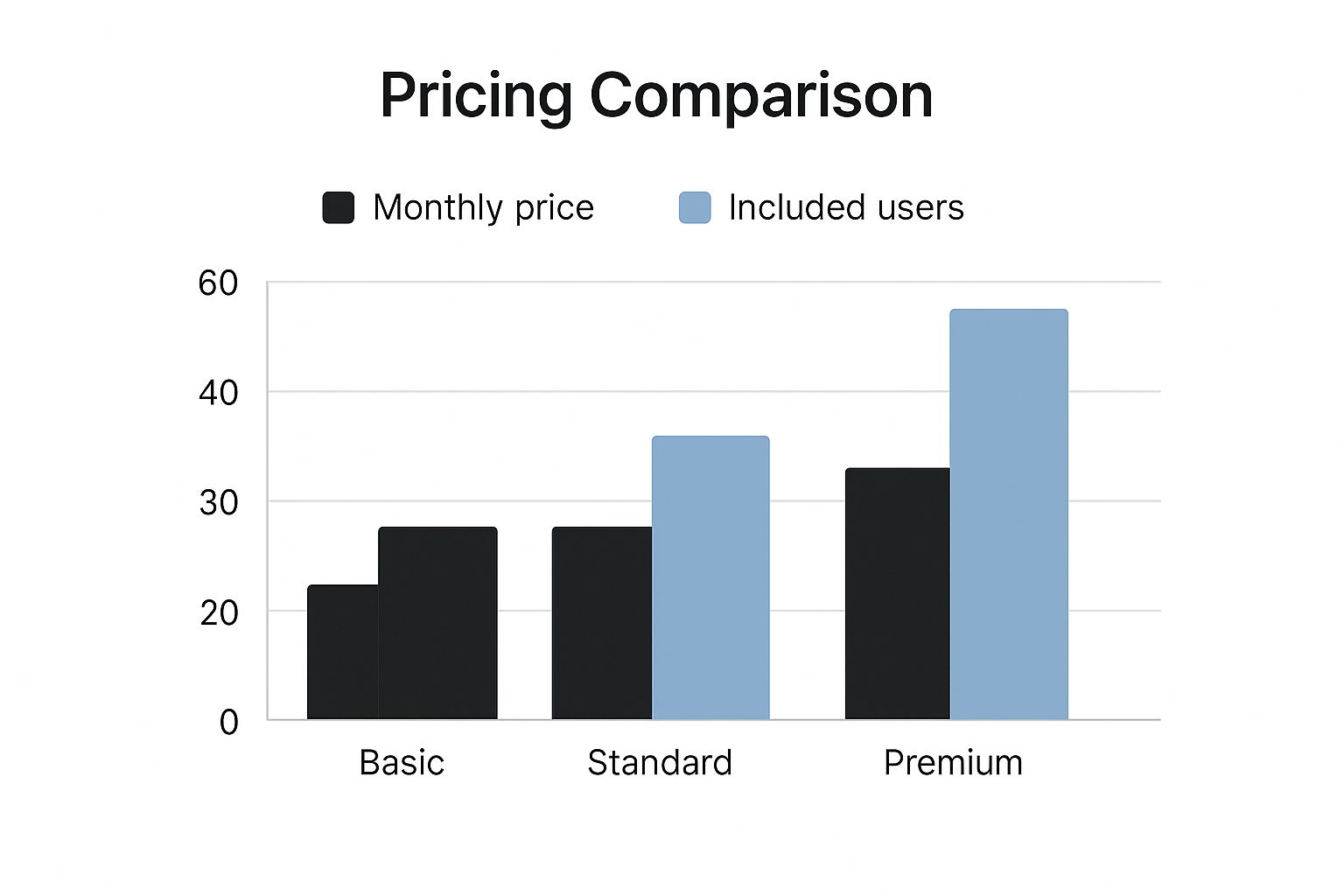
As you can see, the premium plans often deliver a much better per-user value for larger teams. That's a critical point to consider if you're planning to scale your operations.
Feature Deep Dive Across Top PMS Platforms
To get a clearer picture of where each platform really stands out, let's break down some key operational features. This table isn't about every single bell and whistle, but rather the core functions that have the biggest impact on your daily efficiency.
| Feature Category | Platform A (e.g., AppFolio) | Platform B (e.g., Yardi) | Platform C (e.g., Buildium) | Best For… |
|---|---|---|---|---|
| Accounting Engine | All-in-one, user-friendly system. Great for bank syncs and owner statements. | Institutional-grade, handles complex ownership structures and CAMs. | Strong, straightforward tools perfect for growing portfolios. | Yardi for complex commercial/REITs; AppFolio for all-in-one residential. |
| Maintenance | Integrated work orders with mobile app for technicians. | Highly customizable workflows, vendor management. | Simple, effective request tracking and vendor assignment. | AppFolio for mobile-first multifamily; Yardi for custom enterprise workflows. |
| Marketing & Leasing | Built-in listing syndication and AI leasing assistant. | Extensive marketing suite (RentCafe) with robust lead tracking. | Good core features like listing syndication and tenant screening. | Entrata (not listed, but a leader here) for enterprise multifamily marketing. |
| Reporting | Strong pre-built reports for residential performance metrics. | Unparalleled customization for institutional-level financial reporting. | Solid standard reports for owners and property performance. | Yardi for deep, customizable analytics; Buildium for clarity and simplicity. |
Ultimately, the best platform depends entirely on your portfolio's specific needs. A multifamily manager will value AppFolio's seamless mobile experience, while a commercial operator will find Yardi's powerful, customizable reporting indispensable.
Financial Management and Rent Collection
Let’s be honest: automating rent collection and cleaning up the books is a huge reason people shop for new software. The efficiencies you gain here hit your bottom line and free up your team’s time immediately. This goes way beyond a simple online payment portal—it's about the power of the accounting engine running behind the scenes.
A platform's true financial power is revealed in its reporting and reconciliation capabilities. The ability to automatically sync with bank accounts, generate accurate owner statements, and provide a clear audit trail is non-negotiable for serious operators.
AppFolio, for example, gets a lot of praise for its tightly integrated accounting. It’s built to be an all-in-one financial hub for residential managers, cutting down the need to juggle external software like QuickBooks.
Yardi, in contrast, delivers an institutional-grade accounting backbone. It’s built for the complexities of large REITs or commercial operators with diverse assets and sophisticated reporting demands. Meanwhile, Buildium offers clean, strong accounting tools that are perfect for growing portfolios, and Entrata’s system is deeply embedded in its multifamily platform, giving you powerful analytics on property performance.
Tenant Communication and Experience
Today’s tenants expect everything to be digital and seamless. The way a platform handles communication—through portals, mobile apps, and automated texts—has a direct line to your resident satisfaction and retention rates. In fact, a clunky tenant portal is one of the most frequent complaints you'll see in user reviews.
Here's how they stack up:
- AppFolio: Boasts a top-rated, incredibly intuitive tenant portal and mobile app that makes paying rent and logging maintenance requests a breeze. This is a go-to for multifamily operators who live and breathe resident satisfaction.
- Buildium: Delivers a solid resident center with straightforward communication tools and online payments. It’s perfect for small to mid-sized managers who need an effective portal without a steep learning curve.
- Entrata: Offers a full-blown "ResidentPortal" that's more of a community hub. It integrates payments, maintenance, community events, and even package tracking. This is for large-scale multifamily communities building a high-tech, all-inclusive resident experience.
- Yardi: Through its RentCafe suite, it provides a powerful and highly customizable portal that can be adapted to almost any property type. This is the choice for diverse portfolios that need a flexible, feature-rich interface.
At the end of the day, your operational priorities should drive the decision. A commercial manager wrestling with CAM charges is going to see immense value in Yardi's depth. A multifamily operator trying to boost retention will naturally lean toward the user-centric design of AppFolio or Entrata. This focused property management software comparison is about giving you the clarity to see which system is truly built for your world.
A Closer Look at Security, Deployment, and Integrations
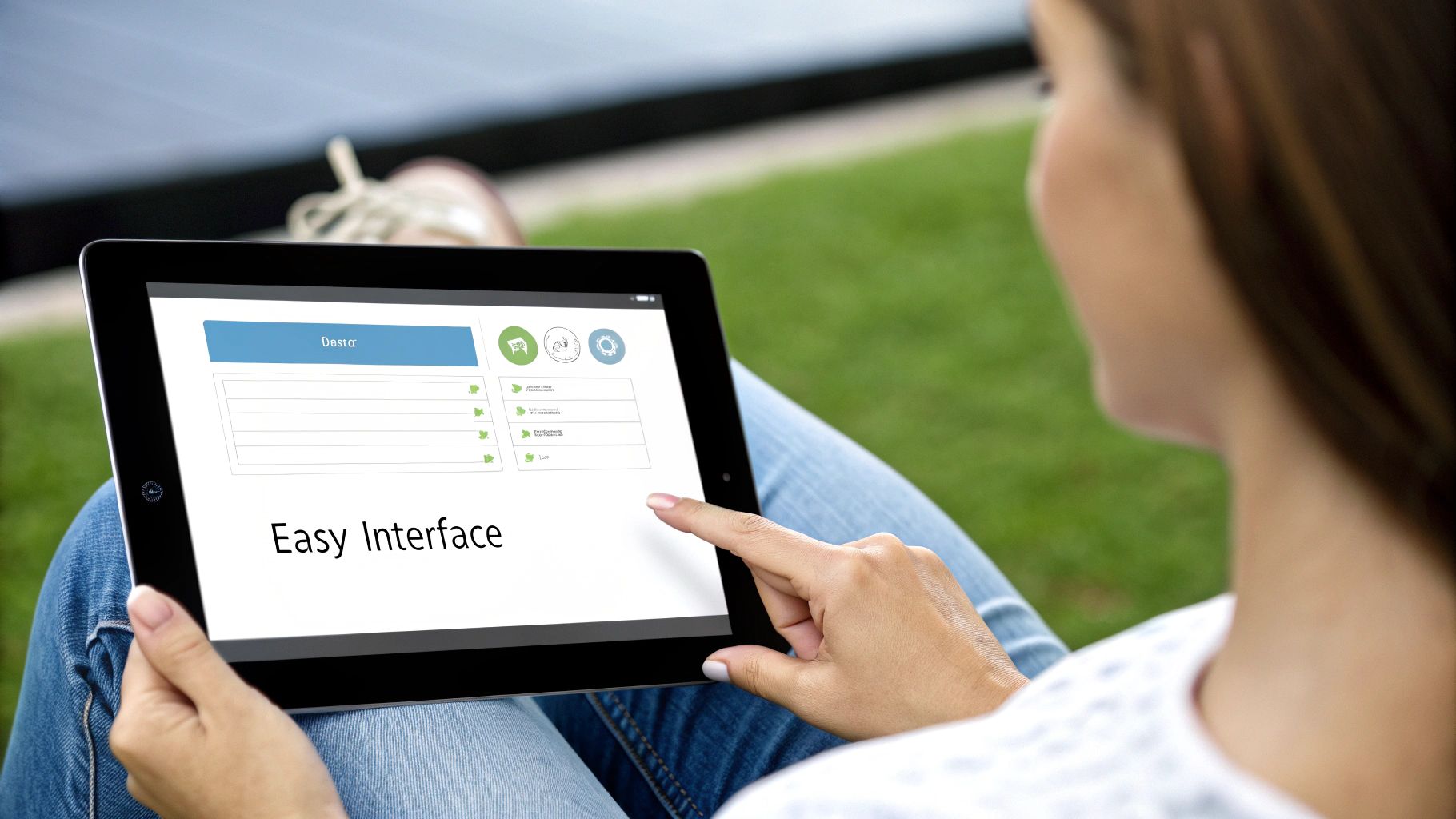
The bells and whistles of a software platform are exciting, but it's the technical foundation that truly determines its long-term value. How a system is deployed, secured, and connected to your other tools will make or break your operational efficiency and resilience. Get this part wrong, and you're not just creating headaches for your team—you're putting your business, tenants, and data at serious risk.
One of the first technical decisions you'll face is the deployment model: cloud-based (SaaS) or a hybrid setup? Cloud platforms are fantastic for accessibility and keeping initial costs down. However, many operators, especially larger ones with strict compliance needs, want more direct control over their data. This is precisely why hybrid solutions are gaining so much momentum.
By mixing the convenience of the cloud with the control of on-premise servers, hybrid models offer a compelling middle ground. This market is growing at a CAGR of 13.9%, which tells you there's a real demand for this balance of access and security. The risks are not theoretical; a major property management provider suffered a cyberattack in 2024 that exposed over 1.5 billion tenant records, a catastrophic event that underscores just how high the stakes are.
Vetting Security Protocols
When you're comparing software, don't let a vendor get away with vague promises of being "secure." You need to dig into the specifics of their security architecture—this should be a deal-breaker on your checklist.
Here are the non-negotiables to look for:
- Data Encryption: Is all of your data—whether it's sitting on a server or being sent across the internet—protected with current standards like AES-256?
- Access Controls: The platform must have role-based access controls (RBAC). This ensures a leasing agent can't access sensitive financial reports and a maintenance tech can't modify tenant ledgers.
- Compliance Certifications: Ask for proof of certifications like SOC 2 Type II. This isn't just a badge; it's an independent audit verifying that the provider meets high standards for security, availability, and confidentiality.
Remember, the software itself is only one piece of the puzzle. Your company's own security practices are just as important. Understanding essential cyber security risk management techniques will help you build a much stronger defense around whichever platform you choose.
The human element is often the weakest link in software security. A system can have the best encryption in the world, but it's still vulnerable if it doesn't enforce things like mandatory two-factor authentication (2FA) and keep detailed audit logs. Without these, you're wide open to phishing attacks or internal mistakes.
Why Integrations and Open APIs Are Game-Changers
Finally, you have to think about how this new software will play with the other tools you already use. A closed system that doesn't talk to anything else is an operational nightmare. It creates isolated pools of data and forces your team into the soul-crushing work of manual data entry.
This is where a healthy integration marketplace or an open Application Programming Interface (API) becomes incredibly valuable. An open API is like a universal translator, letting your property management software communicate seamlessly with other vital systems—whether it’s your accounting software, smart home devices, or advanced marketing tools.
This connectivity creates a unified operational hub, where data flows freely and everyone is working from a single source of truth. Pre-built integrations are great for quick, plug-and-play connections, but a true open API gives you the power to build custom solutions perfectly suited to your unique workflows.
Matching Software to Your Portfolio Type
Trying to find a one-size-fits-all property management software is a surefire way to get frustrated. The platform that works wonders for a small-time landlord with a couple of houses just won't cut it for a large commercial real estate firm. The key to a successful property management software comparison is matching the software’s DNA to the unique demands of your portfolio.
Let's say you're a landlord managing a handful of single-family homes. Your top priority is simplicity, not a hundred features you'll never touch. This is where platforms like TenantCloud or Rentec Direct really shine. They nail the fundamentals—online rent collection, straightforward expense tracking, and easy tenant communication—without the steep learning curve or high price tag of more complex systems.
Multifamily and Residential Portfolios
Once you start scaling, especially in the multifamily world, the game changes completely. It’s all about efficiency. Suddenly, you need a system that can handle volume without adding headcount. This is the sweet spot for all-in-one platforms like AppFolio and Buildium.
These systems are designed to manage the entire resident journey, from the moment a prospect applies online to the day they move out. Think digital lease signing, integrated maintenance requests, and automated communications. For larger apartment communities, a solid tenant portal isn't a "nice-to-have"—it's essential. It becomes the digital hub for residents, and that convenience can make a real difference in your renewal rates.
The real value for multifamily operators comes from building a connected resident experience. When a platform can integrate with other building systems, you create a truly modern living environment. You can learn more about the ultimate guide to smart apartment technology and see how it fits into a broader operational strategy.
Specialized Portfolios: Commercial and Hospitality
Commercial property management is a whole different ballgame. The financial and legal details are far more complex. Your software has to be able to juggle intricate lease clauses, manage common area maintenance (CAM) reconciliations, and calculate percentage rent without breaking a sweat. This is where a heavyweight like Yardi Voyager becomes indispensable. Its institutional-grade accounting and deep reporting capabilities are built for these exact challenges.
Hospitality and short-term rental managers have their own unique set of priorities. They’re less concerned with long-term leases and more focused on the guest experience, managing bookings across multiple sites, and keeping their calendars full.
- Guest Communication: They need tools that automate messages for bookings, check-ins, and review requests.
- Channel Management: The software absolutely must sync with platforms like Airbnb and Vrbo to prevent double bookings.
- Dynamic Pricing: Top-tier solutions offer tools to automatically adjust rates based on demand, local events, and seasonality.
Platforms like Hemlane are built from the ground up for this niche, offering features that cater to the fast-paced nature of short-term rentals. Picking a system designed for your specific property type isn't just about features; it’s about adopting a workflow that’s already proven in your corner of the industry. That alignment is what truly unlocks efficiency and helps your portfolio grow.
Integrating Compliance and Risk Management Tools
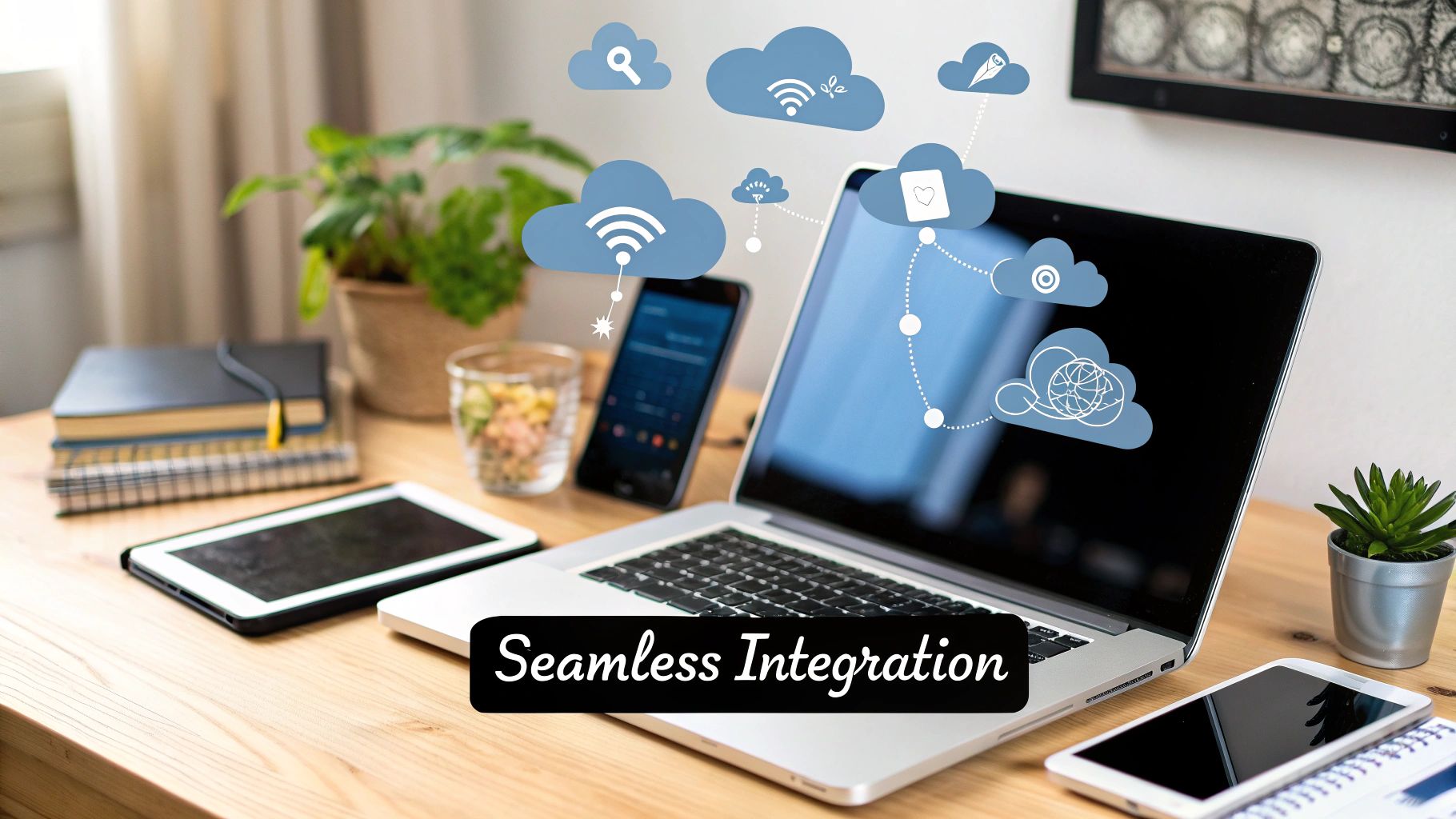
Let's be honest, staying compliant isn't the most glamorous part of property management, but it's absolutely critical. One misstep can lead to serious financial and legal trouble. Your property management software should be your first line of defense, helping you navigate the tricky maze of regulations like Fair Housing laws. A great platform does more than just store documents; it actively helps you manage risk.
The right system will automatically create audit trails, keep detailed logs of tenant communications, and secure your records. These aren't just nice-to-haves; they're essential for proving you've done everything by the book. As you compare different software options, look closely at these features. For example, can the software help you screen vendors and track their insurance and licensing credentials?
This is a bigger deal than it sounds, especially as you rely more on outside contractors for everything from plumbing to security. Software that automates compliance and risk management is non-negotiable for reducing both financial exposure and reputational damage. The best platforms help you keep an eye on vendor performance and ensure everyone is following privacy laws, a must-have for any large-scale operation.
Automated Audits and Secure Document Storage
The strongest platforms have features baked in that actively protect your business. You should be looking for software that automatically logs every meaningful action—from the moment a maintenance request is submitted to when a lease is updated. This creates a solid digital paper trail that can be a lifesaver during a legal dispute or a formal audit.
Secure document storage is another deal-breaker. Your software needs to be a central, encrypted vault for all your important files. This includes:
- Lease agreements and any addendums
- Tenant applications and screening results
- Vendor contracts and insurance certificates
- Incident reports and communication records
A key differentiator here is how a platform handles vendor compliance. A top-tier system won’t just store a vendor’s insurance certificate. It will actively alert you when that certificate is about to expire, stopping you from accidentally sending an uninsured contractor to one of your properties.
Proactive Risk Mitigation Strategies
Beyond just reacting and recording, the best software helps you get ahead of potential problems. Think about features like automated reminders for routine property inspections, smoke detector checks, or other recurring safety tasks. These tools do more than just check a box; they help you maintain a safe environment for residents and give you documented proof of your diligence.
Ultimately, having these features integrated into one system protects your assets from expensive legal battles and preserves your professional reputation. A comprehensive IT security audit is a huge part of this overall strategy. For a more detailed look, check out our guide on creating an IT security audit checklist to make sure your entire tech setup is secure. Choosing a platform with robust, built-in compliance tools is a direct investment in the long-term health of your business.
Frequently Asked Questions
When you're down to the final few contenders in your software search, the questions tend to get more practical. It's no longer just about features; it's about what happens after you sign the contract. Getting straight answers here is key to making a choice you won't regret.
How Do I Calculate the Real ROI of New Software?
Figuring out the true return on your investment is more than just stacking the subscription cost against your budget. You have to look at the ripple effect it has across your entire operation.
Start with the obvious wins: the time your team gets back from automating rent collection or streamlining maintenance requests. Then, dig deeper. Think about the direct financial gains from cutting down vacancy rates thanks to better marketing and screening tools. A solid platform should pay for itself within 12-18 months when you add all these savings up.
One of the most overlooked parts of ROI is risk management. Think about the cost of one Fair Housing lawsuit or the fines from using an uncertified vendor. Good software helps you avoid these disasters, and that 'avoided cost' is a massive, tangible part of its value.
What Does the Implementation and Data Migration Actually Look Like?
Every provider handles this a bit differently, but the general roadmap is pretty consistent. It all kicks off with a discovery phase, where the provider gets the lay of the land—figuring out how to map your current data, whether it’s buried in spreadsheets or locked in another system.
The heavy lifting is the data migration itself, where all your tenant records, lease details, and payment histories are moved over securely. After that, it’s all about configuring the system to your needs and—critically—getting your team trained up. For a small portfolio, you might be up and running in a few weeks; for a large enterprise with complex needs, it could take a few months.
How Can I Get My Team to Actually Use the New Software?
This part is more about people than technology. A smooth rollout hinges on clear communication, great training, and showing your team why this change is good for them from the get-go.
- Get buy-in early: Don't just spring the new software on them. Pull key people from different departments into the demos and selection process.
- Pick a champion: Find that one person on your team who's tech-savvy and can be the internal "go-to" expert for everyone else.
- Show them the 'WIIFM' (What's In It For Me?): Frame the benefits in personal terms. Show your leasing agents how it makes commission tracking a breeze or your maintenance crew how they can close out work orders from their phones. When they see it makes their job easier, adoption happens naturally.
Ready to build a smarter, more secure property portfolio? Clouddle Inc delivers integrated technology solutions—from networking and Wi-Fi to advanced security—that are built to perform. Discover how our managed services can boost your operational efficiency and resident satisfaction.


